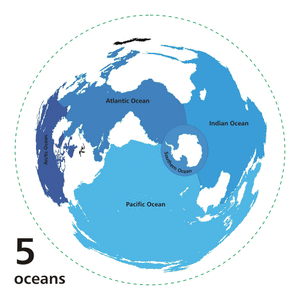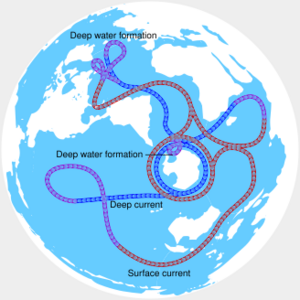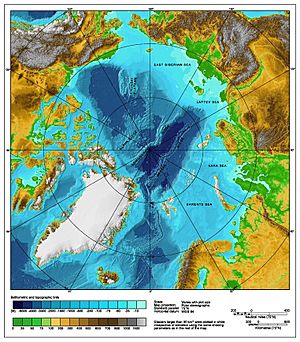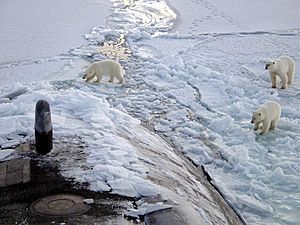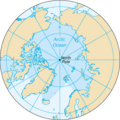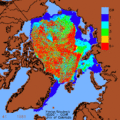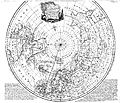Arctic Ocean facts for kids
| Earth's ocean |
|---|
|
Main five oceans division:
Further subdivision: Marginal seas |
The Arctic Ocean is the smallest and shallowest of Earth's five main oceans. It covers about 14 million square kilometers (5.4 million square miles) and is the coldest ocean.
It's the ocean that surrounds the North Pole. The northern parts of Eurasia (Europe and Asia) and North America are next to it. In winter, thick ice and snow cover almost the entire ocean. Even in summer, most of it stays covered. Special ships called icebreakers or nuclear submarines can travel through the Northwest Passage in the Arctic Ocean. This route connects the Pacific and Atlantic oceans.
The ice in the middle of the ocean is usually about 3 meters (10 feet) thick. The biology (plant and animal life) here is very special. Some endangered species that live here include walruses, whales, and polar bears. Sadly, the Arctic Ocean is losing more and more ice each year because of global warming.
The Arctic Ocean is about 1,038 meters (3,406 feet) deep on average. The deepest spot is in the Eurasian Basin, which goes down about 5,450 meters (17,880 feet).
Contents
Geography of the Arctic Ocean
The Arctic Ocean covers an area of about 14 million square kilometers (5.4 million square miles). Its coastline is about 45,390 kilometers (28,200 miles) long. It is surrounded by large landmasses like Eurasia, North America, and Greenland, as well as many islands.
This ocean includes several smaller seas and bays. Some of these are Baffin Bay, Barents Sea, Beaufort Sea, Chukchi Sea, East Siberian Sea, Greenland Sea, Hudson Bay, Hudson Strait, Kara Sea, Laptev Sea, and White Sea. It connects to the Pacific Ocean through the Bering Strait. It also connects to the Atlantic Ocean through the Greenland Sea and Labrador Sea.
The countries that share a border with the Arctic Ocean are Russia, Norway, Iceland, Greenland (part of Denmark), Canada, and the United States.
Arctic Climate
The Arctic Ocean is in a polar climate zone. This means winters have very cold and steady weather. They also have a "polar night," where the sun doesn't rise for months. The skies are often clear.
The temperature of the Arctic Ocean's surface stays pretty much the same, close to the freezing point of saltwater. Saltwater needs to get colder than fresh water to freeze. It must reach about -1.8 °C (28.8 °F) before it turns into ice.
The amount of ice covering the Arctic Ocean changes a lot with the seasons. In winter, much more ice forms. Most of the Arctic ice is covered in snow for about 10 months of the year. The most snow is usually seen in March or April, about 20 to 50 centimeters (7.9 to 19.7 inches) thick.
The climate in the Arctic has changed a lot over a long time. About 55 million years ago, the region was much warmer. The average yearly temperature was 10–20 °C (50–68 °F). The surface waters were warm enough for tropical plants and animals to live there.
Animals and Plants of the Arctic
Many amazing marine animals live in the Arctic Ocean. Some endangered species include walruses and whales. The Arctic has a very delicate ecosystem. This means it changes slowly and takes a long time to recover if it gets damaged. Large Lion's mane jellyfish are common here. The banded gunnel is a type of fish that only lives in this ocean.
The Arctic Ocean doesn't have a lot of large plants. However, it has huge amounts of tiny plant-like organisms called phytoplankton. Phytoplankton are super important because they are the base of the ocean's food web. They get their food from nutrients carried by rivers and ocean currents from the Atlantic and Pacific oceans.
During the summer, the sun shines day and night in the Arctic. This helps the phytoplankton to photosynthesize (make their own food using sunlight) for long periods. This allows them to grow and reproduce very quickly. But in winter, there is very little light, so they struggle to survive.
Natural Resources
The Arctic region is rich in natural resources. These include oil and natural gas fields. There are also placer deposits (valuable minerals found in sand and gravel), polymetallic nodules (rock-like lumps with metals), and lots of sand and gravel. The ocean also has many fish, seals, and whales.
There is a special area near the center of the Arctic Ocean that is not claimed by any country. This area is becoming a point of discussion between the United States, Russia, Canada, Norway, and Denmark. It's important for the world's energy market because it might hold 25% or more of the world's undiscovered oil and gas.
Images for kids
-
Emanuel Bowen's map from the 1780s, showing a "Northern Ocean".
-
A map showing the Northeast Passage, the Northern Sea Route, and the Northwest Passage.
-
A tiny copepod, a type of zooplankton.
-
The Kennedy Channel, a narrow strait in the Arctic.
-
A Minke whale, one of the smaller baleen whales.
-
Walruses resting on ice floes in the Arctic.
See also
 In Spanish: Océano Ártico para niños
In Spanish: Océano Ártico para niños


